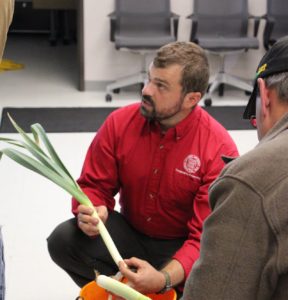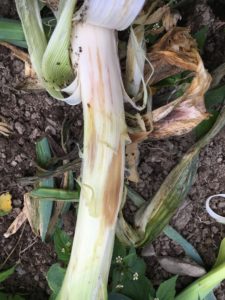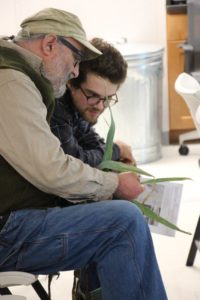(Spanish translation to follow/traducción en español abajo)
Researchers share tactics on saving onion and garlic
Since detected in 2015 in the northeast region, the Allium Leafminer has posed considerable challenges to onion and garlic growers. By laying eggs inside leaf tissue, the pest leaves the plant vulnerable to damage, laying its claim with the oviposition mark, a trail of white dots where female insects have deposited their eggs.
Allium Leafminer (also known as ALM) has been found in 14 counties in New York State. Researchers say it is making its way into Massachusetts and Vermont. The ALM maggots often lead to rot inside the crops, deeming them unmarketable.
Growers who follow organic practices face an added challenge – the limited number of insecticides they can use to battle the invasive pest. Over the past four years, Teresa Rusinek and Ethan Grundberg, researchers from Cornell Cooperative Extention Eastern New York Commercial Horticulture, have been studying the impact of ALM with the goal of finding solutions to help farmers.
The research, “an envisioned multi-year process,” includes identifying which cultural strategies and insecticides work and “figuring out how we can reduce the number of insecticide applications and then can we develop more integrated programs,” Grundberg says.
A large part of the work is sharing what they have learned with regional growers including at conferences. In October, Rusinek and Grundberg presented key findings from their latest research on ALM at the Allium Leafminer Twilight Meeting held at the Hudson Valley Farm Hub.
Since 2018 the Farm Hub has served as the organic farming test site for the research project, while Migliorelli Farm in Red Hook has been the test site for both conventional and organic farming. The fall 2018 trial at the Farm Hub focused on leeks and scallions and examined management methods, from the timing of sprays to the use of reflective mulch to the combination of various methods. This past spring the research was extended to test garlic. The biannual trials are critical since ALM has two flights a year, once in the fall and once in the spring.
Sharing knowledge
At the twilight meeting, Rusinek and Grundberg shared the following key takeaways from the fall and spring trials:
- Row cover is one of the most effective ways to eliminate damage, but it can be challenging for growers as it is often labor-intensive to put in.
- Reflective mulch with a couple of sprays of Entrust (an insecticide approved by the National Organic Standards Board) and with row cover can be a good tactic.
- The insecticide Entrust mixed in a solution of M-Pede can be effective for better penetration of the waxy cuticle, if row cover isn’t used.
- Timing of spraying is critical too; based on the fall research on leeks, two applications of Entrust plus M-Pede work best, especially between three to four weeks after the first signs of ALM.
- Don’t spray too early. Within a consecutive six-week window of ALM flight, spraying during weeks three and four resulted in the lowest number of damaged plants. “During the middle of the flight, the ladies and gentlemen are all out and socializing so the chances you are catching the eggs as they hatch is much greater,” Rusinek explains.
- To check for infestation, growers should look for adult oviposition marks from a minimum of 10 plants at 10 sites on each field on a weekly basis until the activity is observed.
Grundberg notes the research findings, especially the timing of the sprays, can be useful for conventional farms too. Conventional farmers often apply Radiant to battle ALM, but “the results can look very similar,” he says referring to insecticides organic farmers use. Finally, the various ALM management tactics reduce infestation, but none has completely eliminated it.
Looking ahead
An important part of the research is replicating the trial before “we are confident with the results,” Grundberg says. This fall the Cornell researchers repeated the trial on leeks, the final trial for this project held at the Farm Hub. With a new grant from Sustainable Agriculture Research & Education, the researchers are taking the ALM trial next to a commercial farm, in this instance Row by Row Farm in Hurley. Rusinek and Grundberg are committed to continuing the research and sharing the latest updates with the agricultural community.
“I know growers want solutions and they want them now. We do our best to share the most updated results through our newsletter and through presentations at grower meetings, but from a more rigorous scientific perspective until we see replication we are more reluctant to boldly claim we have it figured out,” says Grundberg.
–Amy Wu
For more information on Allium Leafminer
New York State Integrated Pest Management
Cornell University
Penn State Entomology
Combatir el minador de las hojas de la cebolla
LOS INVESTIGADORES COMPARTEN TÁCTICAS SOBRE CÓMO PROTEGER LA CEBOLLA Y EL AJO
Desde que fue detectado en la región del noreste en 2015, el minador de las hojas de la cebolla (Allium Leafminer) ha causado muchos problemas y dificultades para los agricultores de la cebolla y el ajo. Al poner sus huevos dentro del tejido de las hojas, esta plaga perjudica las plantas, dejándolas vulnerables a que se pudran y apoderándose de ella con marcas de oviposición, un camino de puntos blancos donde las hembras han depositado sus huevos.
Desde que el minador de las hojas de la cebolla (también conocido como Allium Leafminer, o ALM) se detectó en Hudson Valley en 2016, se ha encontrado en 14 condados del estado de Nueva York. Los investigadores informan que esta plaga ha llegado a Massachusetts y Vermont. Las larvas del ALM muy a menudo conllevan a que se pudra el interior de los cultivos, lo cual significa que los cultivos no se pueden vender.
Los agricultores que implementan prácticas orgánicas tienen un desafío adicional – la cantidad limitada de insecticidas que pueden utilizar para batallar contra esta plaga invasiva. En los últimos cuatro años, Teresa Rusinek y Ethan Grundberg, investigadores de la cooperativa Cornell Cooperative Extention Eastern New York Commercial Horticulture, han investigado el impacto del ALM con la meta de encontrar soluciones que puedan ayudar a los agricultores.
La investigación, “prevista como un proceso de múltiples años”, incluye identificar qué estrategias culturales e insecticidas funcionan y “averiguar cómo podemos reducir la cantidad de aplicaciones y entonces desarrollar programas más integrados”, dice Grundberg.
Una parte importante del trabajo es compartir los saberes que han surgido de la investigación con los agricultores de la región, ya sea en conferencias o reuniones independientes. En octubre, Rusinek y Grundberg presentaron los hallazgos principales de su más reciente investigación sobre el ALM en el Allium Leafminer Twilight Meeting, una reunión en Hudson Valley Farm Hub.
Desde 2018, Farm Hub ha servido como campo de prueba de agricultura orgánica para el proyecto de investigación, mientras que el rancho Migliorelli Farm en Red Hook ha servido como campo de prueba de agricultura tanto convencional como orgánica. En el otoño de 2018, la prueba en Farm Hub se enfocó en el puerro y la cebolla larga (cebolleta) y exploró métodos de manejo, desde el control de los tiempos para el uso de insecticidas en aerosol hasta el uso del acolchado reflectivo y la combinación de varios métodos. En la primavera pasada, la investigación se extendió para experimentar con el ajo. Las pruebas bianuales son críticas, ya que el ALM tiene dos vuelos por año, uno en otoño y otro en primavera.
Compartir saberes
En la reunión de ALM Twilight Meeting, Rusinek y Grundberg compartieron los siguientes hallazgos clave de las pruebas del otoño y la primavera:
- Utilizar cubiertas flotantes de fila es una de las estrategias más efectivas para eliminar el daño, pero puede ser un poco difícil implementar esta estrategia, ya que instalarlas requiere un trabajo intenso para los agricultores.
- Utilizar acolchado reflectivo con un poco de aerosol Entrust (un insecticida aprobado por la Junta Nacional de Estándares Orgánicos) y coberturas flotantes de fila puede ser una buena táctica.
- Si no se utilizan coberturas flotantes de fila, el insecticida Entrust mezclado en una solución de M-Pede puede ser efectivo para penetrar la cutícula cerosa.
- El control del tiempo es crítico también; según la investigación del puerro del otoño, dos aplicaciones de Entrust más M-Pede funcionan mejor, especialmente entre tres y cuatro semanas después de las primeras señales del ALM.
- No aplique aerosoles demasiado pronto. Dentro de una ventana de seis semanas consecutivas del vuelo del ALM, la aplicación de aerosol durante las semanas tres y cuatro resultó en la menor cantidad de plantas dañadas. “Durante la mitad del vuelo, las hembras y los machos están todos fuera y socializándose, así que la probabilidad de que tú cojas los huevos mientras las crías están rompiendo el cascarón es mucho más alta”, explica Rusinek.
- Para chequear si hay infestación, los agricultores deben buscar semanalmente marcas de oviposición adulta en un mínimo de 10 plantas en 10 lugares distintos de cada campo, hasta que se observe actividad.
Grundberg menciona que los hallazgos de la investigación, especialmente el control de tiempo para el uso de aerosoles puede ser útil para ranchos convencionales también. Los agricultores convencionales a menudo utilizan Radiant para batallar el ALM, pero “los resultados son muy similares”, dice refiriéndose a los insecticidas que los agricultores orgánicos utilizan. Finalmente, varias tácticas de manejo del ALM reducen la infestación, pero ninguna lo ha eliminado completamente.
Con miras hacia el futuro
Una parte importante de la investigación es replicar las pruebas antes de que “estemos seguros de los resultados,” dice Grundberg. Este otoño, los investigadores de Cornell repetirán las pruebas con el puerro, este será el periodo de prueba final para este proyecto en Farm Hub. Con un nuevo de apoyo del fondo Sustainable Agriculture Research & Education, los investigadores llevarán la prueba del ALM a un rancho comercial, en este caso será el rancho Row by Row Farm en Hurley. Rusinek y Grundberg se comprometerán a continuar la investigación y compartir los últimos hallazgos continuamente con la comunidad agricultora.
“Sé que los agricultores quieren soluciones y las quieren ya. Hacemos lo posible por compartir nuestros últimos hallazgos por medio de nuestro boletín y presentaciones en reuniones de agricultores, pero, desde una perspectiva científica más rigurosa, hasta que no veamos que estas estrategias se pueden replicar, no nos sentimos suficientemente cómodos como para declarar que hemos encontrado una solución”, dice Grundberg.
–Amy Wu



